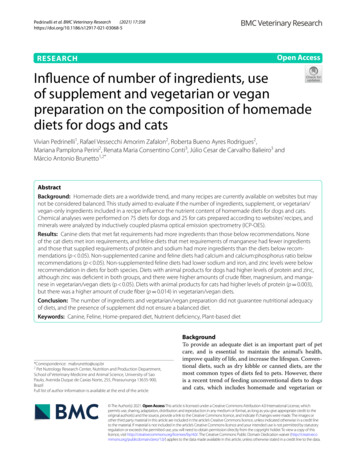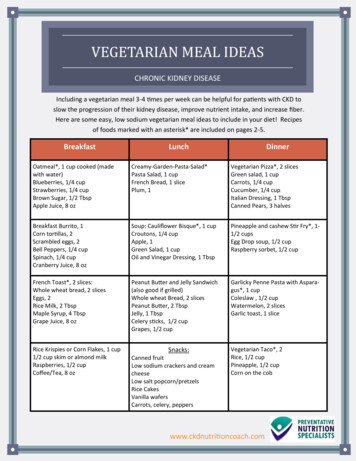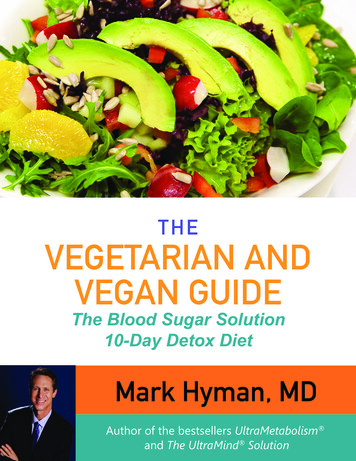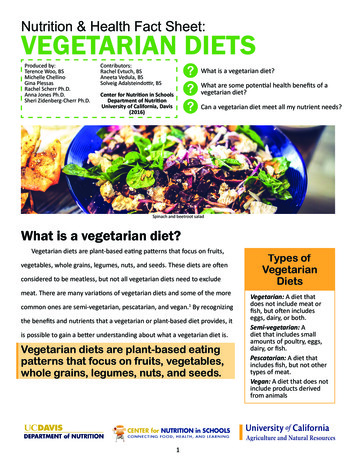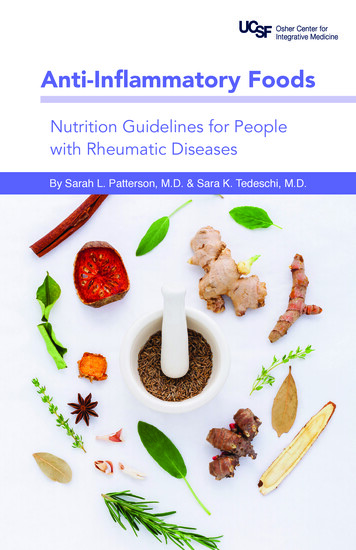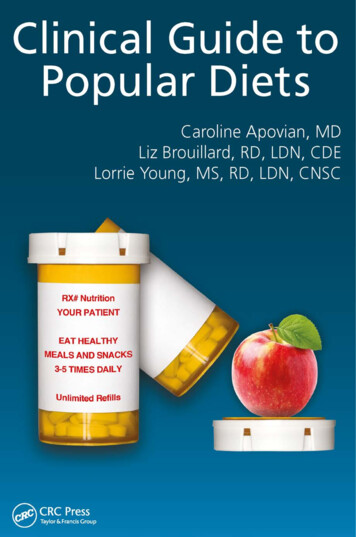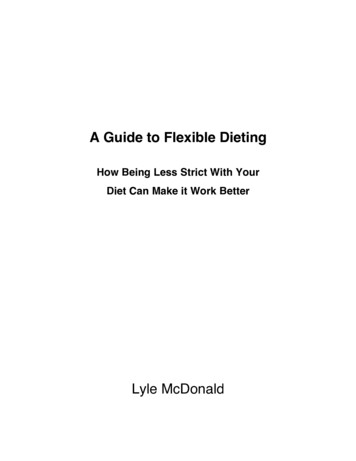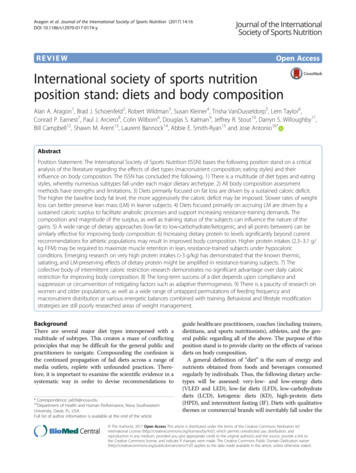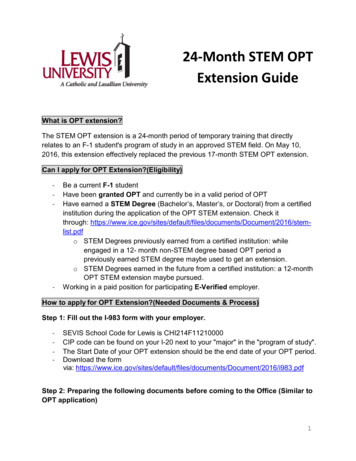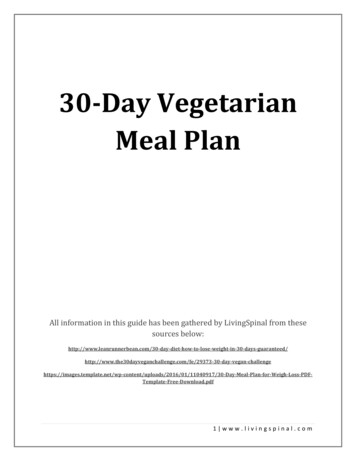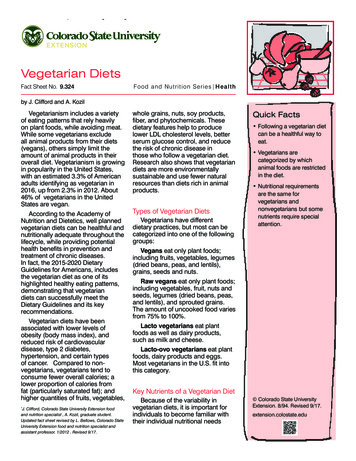
Transcription
Vegetarian DietsFact Sheet No. 9.324Food and Nutrition Series Healthby J. Clifford and A. KozilVegetarianism includes a varietyof eating patterns that rely heavilyon plant foods, while avoiding meat.While some vegetarians excludeall animal products from their diets(vegans), others simply limit theamount of animal products in theiroverall diet. Vegetarianism is growingin popularity in the United States,with an estimated 3.3% of Americanadults identifying as vegetarian in2016, up from 2.3% in 2012. About46% of vegetarians in the UnitedStates are vegan.According to the Academy ofNutrition and Dietetics, well plannedvegetarian diets can be healthful andnutritionally adequate throughout thelifecycle, while providing potentialhealth benefits in prevention andtreatment of chronic diseases.In fact, the 2015-2020 DietaryGuidelines for Americans, includesthe vegetarian diet as one of itshighlighted healthy eating patterns,demonstrating that vegetariandiets can successfully meet theDietary Guidelines and its keyrecommendations.Vegetarian diets have beenassociated with lower levels ofobesity (body mass index), andreduced risk of cardiovasculardisease, type 2 diabetes,hypertension, and certain typesof cancer. Compared to nonvegetarians, vegetarians tend toconsume fewer overall calories; alower proportion of calories fromfat (particularly saturated fat); andhigher quantities of fruits, vegetables,J. Clifford, Colorado State University Extension foodand nutrition specialist , A. Kozil, graduate student.Updated fact sheet revised by L. Bellows, Colorado StateUniversity Extension food and nutrition specialist andassistant professor. 1/2012 . Revised 9/17.*whole grains, nuts, soy products,fiber, and phytochemicals. Thesedietary features help to producelower LDL cholesterol levels, betterserum glucose control, and reducethe risk of chronic disease inthose who follow a vegetarian diet.Research also shows that vegetariandiets are more environmentallysustainable and use fewer naturalresources than diets rich in animalproducts.Types of Vegetarian DietsVegetarians have differentdietary practices, but most can becategorized into one of the followinggroups:Vegans eat only plant foods;including fruits, vegetables, legumes(dried beans, peas, and lentils),grains, seeds and nuts.Raw vegans eat only plant foods;including vegetables, fruit, nuts andseeds, legumes (dried beans, peas,and lentils), and sprouted grains.The amount of uncooked food variesfrom 75% to 100%.Lacto vegetarians eat plantfoods as well as dairy products,such as milk and cheese.Lacto-ovo vegetarians eat plantfoods, dairy products and eggs.Most vegetarians in the U.S. fit intothis category.Quick Facts Following a vegetarian dietcan be a healthful way toeat. Vegetarians arecategorized by whichanimal foods are restrictedin the diet. Nutritional requirementsare the same forvegetarians andnonvegetarians but somenutrients require specialattention.Key Nutrients of a Vegetarian DietBecause of the variability invegetarian diets, it is important forindividuals to become familiar withtheir individual nutritional needs Colorado State UniversityExtension. 8/94. Revised 9/17.extension.colostate.edu
and potential dietary deficiencies.People following a vegetariandiet generally receive adequateamounts of most nutrients.However, the following nutrientsmay be lacking so it is important toassure adequate amounts of thesenutrients in the diet.ProteinProtein is needed for growthand maintenance of body tissues.It also is necessary for enzymes,hormones, antibodies and milkproduction in women who arebreastfeeding. Plant sources ofprotein can provide adequateamounts of essential andnonessential amino acids, if theyare reasonably varied and caloricintake is sufficient to meet energyneeds. Whole grains, legumes,vegetables, seeds and nuts allcontain essential and nonessentialamino acids. Textured vegetableproteins and meat analogues,such as tofu and tempeh (usuallymade from soybeans and fortifiedwith amino acids) are good proteinsources. Soy milk is also a goodsource of protein as it contains thesame amount of protein per servingas cow’s milk. An assortment ofplant foods eaten over the courseof a day can provide all essentialamino acids; thus, complementaryproteins do not need to be eaten atthe same meal.Omega-3 Fatty AcidsAn increasing body of researchshows the many benefits ofomega-3 fatty acids. Thesefats may reduce the risk forcardiovascular disease, improvecognitive function and vision,and act as an anti-inflammatoryagent in the body. The primarysources of omega-3 fatty acidsin the diet are fish, organ meats,and DHA-enriched foods suchas eggs. Based on these foodsources, vegetarians may notget enough omega-3 fatty acidsin their diet. However, evidencesuggests the healthy individualscan meet their omega- 3 needs byconsuming adequate amounts ofomega-3 containing plant foodslike flaxseed, chia seeds, hempseeds, walnuts, canola oil andsoy. Vegetarians can also choosefrom the increasing variety ofDHA-enriched foods sold in themarketplace, such as some soymilks and breakfast bars. Finally,capsule supplements made fromDHA-rich microalgae are available,but it is always important to consulta healthcare provider before takinga supplement.IronIron combines with protein toform hemoglobin, the substance inthe blood that carries oxygen andcarbon dioxide. An adequate intakeof iron is necessary to preventanemia. Many Americans, bothmeat-eaters and vegetarians, havea difficult time consuming enoughiron.While vegetarians generallyconsume as much, or slightly moreiron than omnivores, vegetarianstypically have lower iron storesthan non-vegetarians. This is dueto the fact that the iron in animalfoods is more easily absorbedby the body than the iron in plantfoods. The iron in plant foodsmay be less available to the bodybecause of the high fiber contentin plants. Fiber is not absorbed intothe body and may tie up minerals,such as iron, so they, too, are notabsorbed. For these reasons,vegetarians may be at a higherrisk for developing iron deficiency.Because women need more ironthan men they especially need topay attention to iron.Recent research has shownhowever, that some individualscan adapt to absorb plant basediron (non-heme iron) almost aseffectively as animal based iron(heme iron). One study found thattotal iron absorption increasedby almost 40% after 10 weeks ofconsuming a plant-based diet.Even so, the daily recommendationfor iron intake is 1.8 times higherfor vegetarians than those who eatmeat.Among plant foods, dark greenleafy vegetables have the highestiron content. Dried fruits (suchas raisins, apricots, peaches andprunes) also are high in iron. Formaximum iron absorption, it isbeneficial to eat plant sources ofiron at the same meal as foodshigh in vitamin C (Brussels sprouts,strawberries, citrus fruits, broccoli,collard greens, mustard greens,cantaloupe or vitamin C-rich fruitjuices). Vitamin C increases theavailability of iron in the intestinaltract. When vitamin C and ironare eaten together, more iron isabsorbed into the body.ZincAs with iron, zinc is a mineralthat is present in plant foodsbut better absorbed fromanimal sources. As a result,some vegetarians have lowerconcentrations of zinc in the bodythan non-vegetarian diets, butmost vegetarians still have levelswithin the normal range. True zincdeficiencies are rare in Westerncivilizations. Vegetarians canmake sure they consume zincby including foods such as soyproducts, legumes, grains, cheeseand nuts. Like iron, zinc can bebetter absorbed when eaten incombination with vitamin C-richfoods.CalciumCalcium is needed for strongbones and teeth, for normal bloodclotting and for normal muscle andnerve function. Most calcium in theAmerican diet comes from milk andmilk products. When these foodsare avoided, calcium must comefrom other sources. Dark green
Table 1: Healthy Vegetarian Eating Pattern: Recommended Amounts of Food From Each Food GroupDaily Amount of Food From Each Group in Cup and Ounce EquivalentsHealthy U.S.-StyleEating PatternHealthy VegetarianEating PatternFruit2 c-eqVegetables2 ½ c-eqDark green vegetables1 ½ c-eq/week1 ½ c-eq/week5 ½ c-eq/week5 ½ c-eq/weekLegumes(beans and peas)1 ½ c-eq/week1 ½ c-eq/weekStarchy vegetables5c-eq/week5c-eq/weekOther vegetables4c-eq/week4c-eq/weekGrains6 oz-eq6 ½ oz-eqWhole grains3 oz-eq3 ½ oz-eqRefined grains3 oz-eq3 oz-eqDairy3 c-eq3 c-eq1 cup-equivalent is: 1 cup milk, yogurt,or fortified soymilk; 1½ ounces naturalcheese such as cheddar cheese or 2ounces of processed cheese.Protein Foods5 ½ oz-eq3 ½ oz-eq1 ounce-equivalent is: 1 ounce leanmeat, poultry, or seafood; 1 egg; ¼ cupcooked beans or tofu; 1 Tbsp peanutbutter; ½ ounce nuts or seeds.Red and orangevegetablesSeafoodMeat, poultry, eggsNuts, seeds, soyproducts2 c-eqWhat counts as a cup or ounceequivalent (c-eq or oz-eq)?2 ½ c-eq8 oz/wk26 oz/wk5 oz/wkEggs3 oz-eq/wkLegumes(beans and peas)6 oz-eq/wkSoy Products8 oz-eq/wkNuts & Seeds7 oz-eq/wkOils27g1 cup-equivalent is:1 cup raw or cookedvegetable or fruit, 1 cup vegetable or fruitjuice, 2 cups leafy salad greens, ½ cupdried fruit or vegetable.27g1 ounce-equivalent is: ½ cup cookedrice, pasta, or cereal; 1 ounce dry pastaor rice; 1 medium (1 ounce) slice bread; 1ounce of ready-to-eat cereal (about 1 cupof flaked cereal).
leafy vegetables are the plant foodsthat provide the most calcium.Certain plant components, likeoxalates, may inhibit the absorptionof dietary calcium. Calcium fromlow-oxalate green vegetables(broccoli, turnip greens, bok choy,chinese cabbage, collards, kale)is absorbed as well as or betterthan calcium from cow’s milk, at arate close to 50%. In high-oxalatevegetables (spinach, beet greens,and Swiss chard), as low as 5% ofthe available calcium is absorbed.Fruit juices and plant milks fortifiedwith calcium and calcium-set tofuare also good sources of calcium.Calcium deficiency invegetarians is rare, and thereis little evidence to show thatcalcium intakes below the DietaryReference Intake cause majorhealth problems in vegetarians.U.S. recommendations for calciumare relatively high compared tothose for populations that eata more plant-based diet. Highlevels of animal protein increaseurinary loss of calcium. U.S.recommendations are designed tocompensate for this. Studies showthat vegetarians absorb and retainmore calcium from food than donon-vegetarians.Vitamin DVitamin D is required to absorbcalcium from the digestive tract andto incorporate calcium into bonesand teeth. Few foods contain largeamounts of vitamin D and the bestsources–fortified milk, egg yolksand liver–are all of animal origin.Therefore, vegetarians, especiallyvegans, may not get enough.Sunlight is another source ofvitamin D. The body makes vitaminD from sunlight on the skin. Peopleregularly exposed to sunlight canget enough vitamin D withouthaving any come from food.However, sun exposure can belimited by several factors, includingdark skin, pollution and northernlatitudes. If sun exposure is limitedand there are no animal productsin the diet a vitamin D supplementis recommended.Vitamin B-12Vitamin B12 is needed fornormal red blood cell formationand normal nerve function. Thebody needs only small amountsand can store it in large amounts.Therefore, a deficiency takesa long time to develop, maybeseveral years. Once a deficiencydoes develop, however, it resultsin irreversible nerve damage.Vegetarians need to pay specialattention to this nutrient, as it is notfound in common plant foods.Vegetarians who consumedairy products and/or eggs dailyshould get enough vitamin B12in their diets. Vegans, however,have little or no vitamin B12 in theirdiets and must obtain the vitaminthrough regular use of a vitaminB12 supplement or through foodsources, such as, nori, spirulina,chlorella, algae, unfortifiednutritional yeast, fermented foods(such as tempeh fermented withbeneficial bacteria), commercialbreakfast cereals, or fortified soybeverages.IodineIodine is as an essentialcomponent of the thyroidhormones thyroxine (T4) andtriiodothyronine (T3), whichregulate a number of biochemicalreactions in the body. The primaryfood sources of iodine are seavegetables, sea food, and dairyproducts, so plant-based diets areoften low in iodine Vegans maybe at risk for iodine deficiency,so they should make a point toinclude sea vegetables (such askelp, nori, kombu, and wakame)and iodized salt in their diets. It isalso important to note, that whileiodized salt contains iodine, seasalt and kosher salt do not. Saltyseasonings, such as tamari andsoy sauce are generally not iodizedeither. Lacto-vegetarians can getiodine from dairy products, butiodine content in dairy foods variesconsiderably.Some vegetables, such assoybeans, sweet potatoes andcruciferous vegetables suchas broccoli and cabbage, areconsidered goitrogens, becausethey interfere with iodineabsorption. These foods however,have not been associated withthyroid insufficiency in healthyindividuals with adequate iodineintake.Planning a Nutritious VegetarianDietVegetarians should follow thediet principles recommended in theDietary Guidelines for Americans.Well-planned vegetarian diets caneffectively meet these guidelinesand be a health-supportingdietary option. The 2015-2020Dietary Guidelines includes theHealthy Vegetarian Eating Patternas one of three eating patterns,along with the Healthy U.S.-StyleEating Pattern and the HealthyMediterranean-Style Eating Pattern,that can be adapted based oncultural and personal preferencesto meet the Dietary Guidelines andits Key Recommendations. Therecommendations, as outlinedin Table 1, the Healthy U.S.-StyleEating Pattern and the HealthyVegetarian Eating Pattern aresimilar for fruit, vegetables, grainsand dairy. The overall amount ofprotein recommended is less forthe Vegetarian Eating Pattern andthe types of protein foods andamounts for each of these foodsvary.Vegetarian Protein OptionsBeans and PeasDry beans and peas, as well aslentils, are considered legumes.Legumes are an excellent food toextend or replace meat. Legumes arelow cost, high in nutritive value, andcontribute iron, B vitamins, and fiber tothe diet. Like most plant sources theyare not a complete protein, meaningthey do not contain all of the essentialamino acids the body needs. Whencombined with a variety of other plantfoods throughout the week, driedbeans and peas can become valuableprotein sources in the diet.
Dry beans: Rich in protein, iron,calcium, phosphorus and potassium.Many varieties of dry beans includeblack beans, garbanzo beans (alsocalled chick peas), kidney beans, limabeans, navy beans and pinto beans.Dry peas: Good sources of protein,iron, potassium and thiamin. They aregreen or yellow and can be purchasedsplit or whole.Lentils: Disc-shaped legumessimilar in size to peas. They are rich inprotein, iron, potassium, calcium andphosphorus.Soy ProductsSoy products include tofu, soymilk,tempeh and other products. All arederived from soybeans and are arich source of plant-based protein.Protein in soybeans contains as muchcomplete protein as meat and theyare a good source of B vitamins andessential fatty acids, including someomega-3s. Soy foods are generallylow in saturated fat and trans fat andare cholesterol free. They also containisoflavones which may help lower therisk of some chronic diseases. Thefollowing are common soy productsthat you will find in the marketplace:Soybean: A legume, which isan excellent, inexpensive source ofprotein and iron. Soybeans can beeaten in their whole form and, butare also used to make a number ofvegetarian substitutions for meat, dairy,and eggs.Soy cheese: A cheese-like productmade from soybeans. Soy cheesescome in most of the same varietiesas dairy cheeses, such as parmesan,mozzarella and cheddar. However,some soy cheeses are not vegan asthey contain the animal protein casein.Soymilk: A milk-like product madefrom soybeans, with the same amountof protein and less fat than cow’s milk.Not all soymilks are vegan as somecontain the animal protein casein.Tempeh: Made from fermentedsoybeans, tempeh is a replacement formeat.Textured Vegetable Protein:Commonly used as a substitute forground beef; TVP is derived from soyflour.Tofu: Made from curdled soymilkand pressed into blocks. It is areplacement for meat, eggs andcheese and can be eaten fresh orcooked in many different ways. Tofu isan excellent source of protein. Typesand uses of tofu: Extra-firm tofu: frying, roasting, grilling ormarinatingWell planned vegetarian diets canbe healthful, nutritionally adequate,and may provide health benefits inprevention and treatment of chronicdiseases during all phases of thelifecycle. Firm tofu: stir-frying, boiling or to use asfillingReferences Soft tofu: pureeing Silken tofu: pureeing, simmering, eggsubstitution, used in vegan desserts andsmoothiesNuts and SeedsNuts are one of the best plantsources of protein. They are richin fiber, folic acid, potassium,antioxidants (vitamin E and selenium)and phytochemicals as well. Nutsare high in monounsaturated andpolyunsaturated fatty acids, includingomega 3 fatty acids. Seeds have asimilar nutrient profile to nuts, thusthey’re considered interchangeablewith nuts. Because nuts and seeds arehigh in fat, portions should be limited.Tree nuts: Includes almonds,Brazil nuts, cashews, hazelnuts,macadamias, pecans, pine nuts,pistachios and walnuts.Seeds: Includes pumpkin, sesame,sunflower, and flaxseed. Seeds have asimilar nutrient profile to nuts.Nut butters: Peanut butter is themost popular but other nuts and seedsmake healthful butters: sunflower,almond, hazelnut and soy.SummaryA vegetarian diet can be a healthyway to eat. The key is to consume avariety of foods in the right amounts tomeet your energy and nutrient needs.For vegetarians, it is important to:Academy of Nutrition and Dietetics.(2016). Position of the Academyof Nutrition and Dietetics:Vegetarian Diets. Retrievedfrom: -dietsAcademy of Nutrition and Dietetics.(2014). Vegetarian Glossary ofTerms. Retrieved from: rmsNational Institutes of Health:Office of Dietary Supplements.(2016). Iodine: Fact Sheet forHealthy Professionals. Retrievedfrom: fessional/NationalInstitutes of Health: Office ofDietary Supplements. (2016).Iron: Dietary Supplement FactSheet. Retrieved from: sional/United States Department ofAgriculture. (2016). 2015 DietaryGuidelines for Americans.Retrieved from: s/ Be conscious of protein-rich foods. Yourprotein can easily be met by eating avariety of plant foods, such as beans,peas, soy products, nuts, and seeds. Eat a variety of fruits and vegetables toprovide a wide range of nutrients. Include whole grains and other fiber richfoods. Get enough omega-3 fatty acids,calcium, and vitamin B12.Colorado State University, U.S. Department ofAgriculture and Colorado counties cooperating.CSU Extension programs are available to all withoutdiscrimination. No endorsement of products mentionedis intended nor is criticism implied of products notmentioned.
Nutrition and Dietetics, well planned vegetarian diets can be healthful and nutritionally adequate throughout the lifecycle, while providing potential health benefits in prevention and treatment of chronic diseases. In fact, the 2015-2020 Dietary Guidelines for Americans, includes the vegetarian diet as one of its
